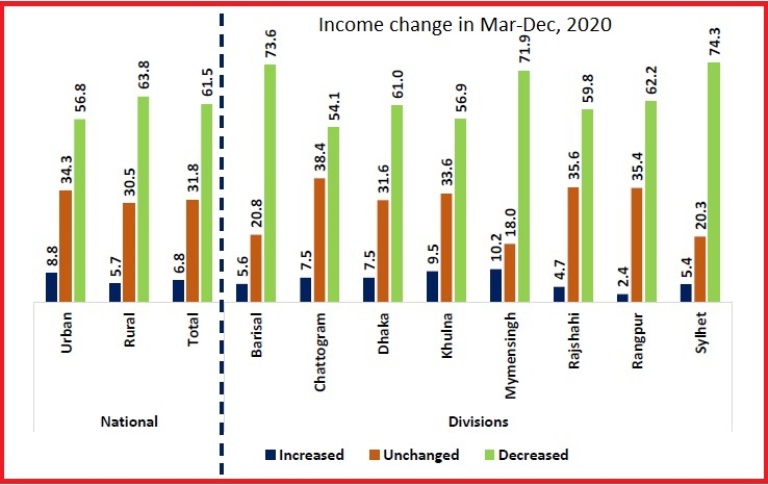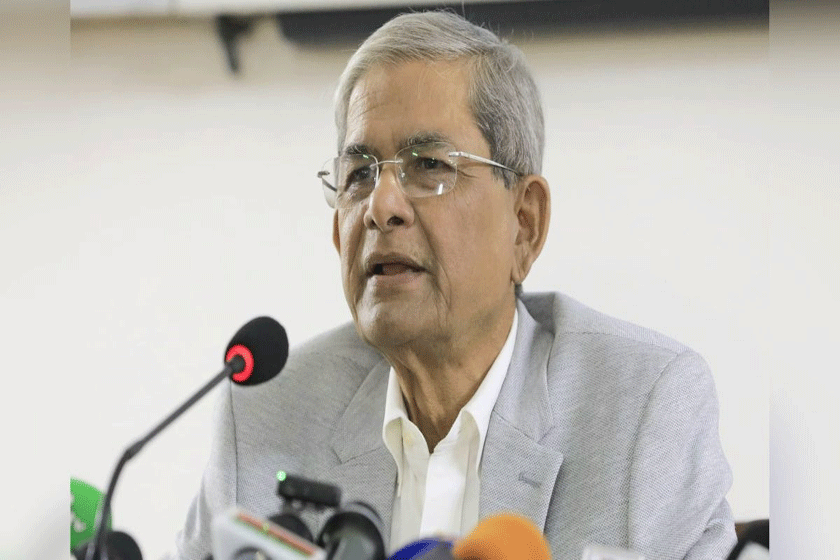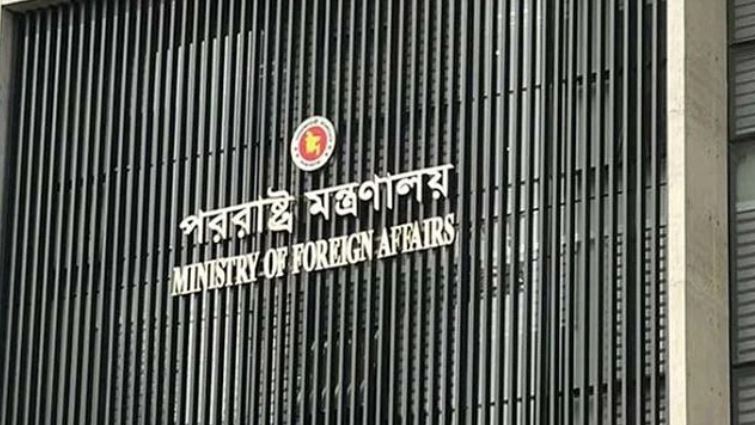
A latest survey suggests that 34.2 percent wage-employed and 37.3 percent self-employed workers whose earnings had declined but income has not yet recovered to the pre-pandemic level. COURTESY
Covid-19 pandemic exposed crucial gaps and fragilities in the employment sector of Bangladesh, like other countries, strongly affecting economic activity as well as labour market leaving millions of workers without adequate work and income. Since a significant proportion of the workforce in Bangladesh is employed in the informal sector, they are the hardest sufferers as like as the self-employed group people as a majority of them are yet to regain their earnings to their previous levels.
A latest survey suggests that 34.2 percent wage-employed and 37.3 percent self-employed workers whose earnings had declined but income has not yet recovered to the pre-pandemic level. In total, 27.8 percent wage-employed and 43.2 percent self-employed workers noted that their income had declined but already recovered between March and December 2020. On the other hand, income of 38 percent wage-employed and 19.5 percent self-employed workers remained unchanged during March-December 2020.
For workers employed in the capital, 61 percent wage-employed workers reported a decline in their earnings, 84.2 percent self-employed workers reported decrease in production, sales and profit while 58.6 percent reported halted business activities. Only 30.1 percent wage-employed workers and 42.5 percent workers based in Dhaka witnessed recovery in their income whereas for 31.1 percent wage-employed and 41.8 percent self-employed workers, recovery was yet to be noted.
The findings of the survey conducted by Sanem, a think-tank were released in a presentation by Dr Sayema Haque Bidisha, Professor, Department of Economics, University of Dhaka and Research Director of SANEM at a webinar on Tuesday. Tuomo Poutiainen, Country Director, ILO Bangladesh, was present as the special guest and Dr Selim Raihan, Professor, Department of Economics, University of Dhaka and Executive Director of SANEM, moderated the webinar.
Dr Ahsan H. Mansur, Executive Director, Policy Research Institute of Bangladesh (PRI); Dr Tasneem Siddiqui, Professor in Political Science and Founding Chair, Refugee and Migratory Movements Research Unit (RMMRU), University of Dhaka; and Dr Khondaker Golam Moazzem, Research Director, Centre for Policy Dialogue (CPD) were panellist. Researchers, economists, academicians, development practitioners, journalists and students from various backgrounds also joined the discussion.
Among the major problems faced by the surveyed wage employed during March-December 2020, 62 percent reported a decrease in their salary. 80 percent of the surveyed self-employed reported a decline in production, profit and sales, and 52.5 percent reported that their business activities had temporarily stopped.
Some 79.6 percent wage employed in the transportation sector reported a decline in their income, followed by 73.6 percent in construction sector, 68.9 percent in RMG manufacturing, 68.2 percent in agriculture, forestry and fishery, 57.8 percent in non-RMG manufacturing, and 57 percent in wholesale and retail trade.
Sylhet, Barisal and Mymensingh were among the worst-affected divisions in terms of the number of workers who faced a decline in their income. On the contrary, more workers employed in urban regions lost their jobs compared to those in rural regions. The highest proportion of workers, 12.94 percent, who lost their jobs belonged to Barisal, followed by 10.21 percent in Chattogram, 9.86 percent in Rangpur, 8.45 percent in Mymensingh, 7.71 percent in Dhaka and 7.06 percent in Sylhet.
Self-employed workers across all sectors experienced significant declines in production, sales, profit. Between December 2019 and December 2020, 78 percent self-employed workers reported a decline in income, the reduction being the largest for self-employed workers in the hotel and restaurant sector and smallest for workers engaged in healthcare and social work.
The outbreak of the COVID-19 pandemic forced almost all governments around the globe to adopt restrictive measures and nationwide lockdowns which led many businesses to temporarily or permanently shut their operations, the report suggests.
Furthermore, the pandemic induced a phenomenon of reverse migration, presenting policymakers with yet another challenge of rehabilitating returnee migrants. SANEM conducted the household level telephone survey with 2845 non-migrants, 230 internal migrants and 273 international migrants from January 2021 to February 2021.
The survey sample is based on SANEM-GED's nationwide comprehensive household survey which was conducted in 2018 on 10,500 households. In order to provide insights into the labour market impacts of the ongoing pandemic, SANEM hosted a webinar on "COVID-19 Impact on Employment and Migration: Findings from SANEM's Survey" on March 10, 2021.
Out of the 230 internal migrants included in the survey, 66.52 percent are working in Dhaka and 20 percent are employed in the RMG sector and 13.5 percent in wholesale and retail trade. 49 percent of these workers were forced to return to their villages due to job loss, no payment, decreased salary while14 percent lost their jobs during March-December 2020.
Dr. Selim Raihan stressed upon the importance of acknowledging the challenges in the labour market imposed by the pandemic and its implications on the social sectors for Bangladesh to continue on its positive development trajectory. He also mentioned that, even before the pandemic, Bangladesh suffered from sluggish private sector investment, poor FDI and slow job creation. Since these issues have been further aggravated by the ongoing economic crisis, strengthening inter-linkages between the product market, factor market and credit market will play a crucial role in the recovery process.
Although several policies have been considered on the national level to initiate the recovery process in the product markets, policies addressing issues in the factor and credit markets are still weak or absent. Lastly, Dr Raihan noted that prior studies have revealed a micro-macro mismatch in which remittance inflow through formal channels have surged, but households reported a decrease in remittance earnings. Failure to address these issues will have serious implications on the livelihoods of households that rely on remittance earnings as their main source of income.
Dr Ahsan H. Mansur highlighted that there is a need to address the problems faced by new entrants in the labor market who have entered the workforce in a time of crisis when demand for labor is comparatively lower. Unless there is a recovery in private sector investment, creation of employment opportunities for fresh graduates and new workers will be challenging. He also pointed out that the reverse internal migration of workers to their villages must be seen as a temporary safeguard against loss of employment caused by the pandemic. However, as employability in rural areas and agricultural sector is already highly saturated, workers will have to either rely on the rural non-farm sector or eventually return to urban areas in search of better work opportunities.
Dr Tasneem Siddiqui observed that the ongoing pandemic has once again emphasized the interdependence between development in rural and urban regions and the importance of internal migration for sustaining livelihoods. She further explained that, although the pandemic has disproportionately affected female employment and participation in the labor force, in case of international migration, it has been seen that job losses and non-payment cases were much higher for male migrant workers compared to female migrant workers. In fact, during the first few months of the pandemic, a higher number of female international migrants could remit compared to male migrants.
Dr Khondaker Golam Moazzem said, regional differences in recovery rates, such as slower recovery in Barisal and Mymensingh, must receive greater attention since they contain important implications for poverty alleviation policies. He suggested that further analysis of the data to document the differences in the experience of migrant workers belonging to different income groups and social backgrounds could also reveal interesting results.
Tuomo Poutiainen acknowledged that the global labor markets, consumption patterns and international trade will continue to be unpredictable as the recovery process is still tentative and long-term impacts on employment are yet to be fully discovered. Issues around social protection programs for formal workers and the various welfare programs that are available for informal workers have revealed that these systems are not adequately prepared to withstand such large shocks and this has further reemphasized the urgent need for a comprehensive social protection system.












0 Comments